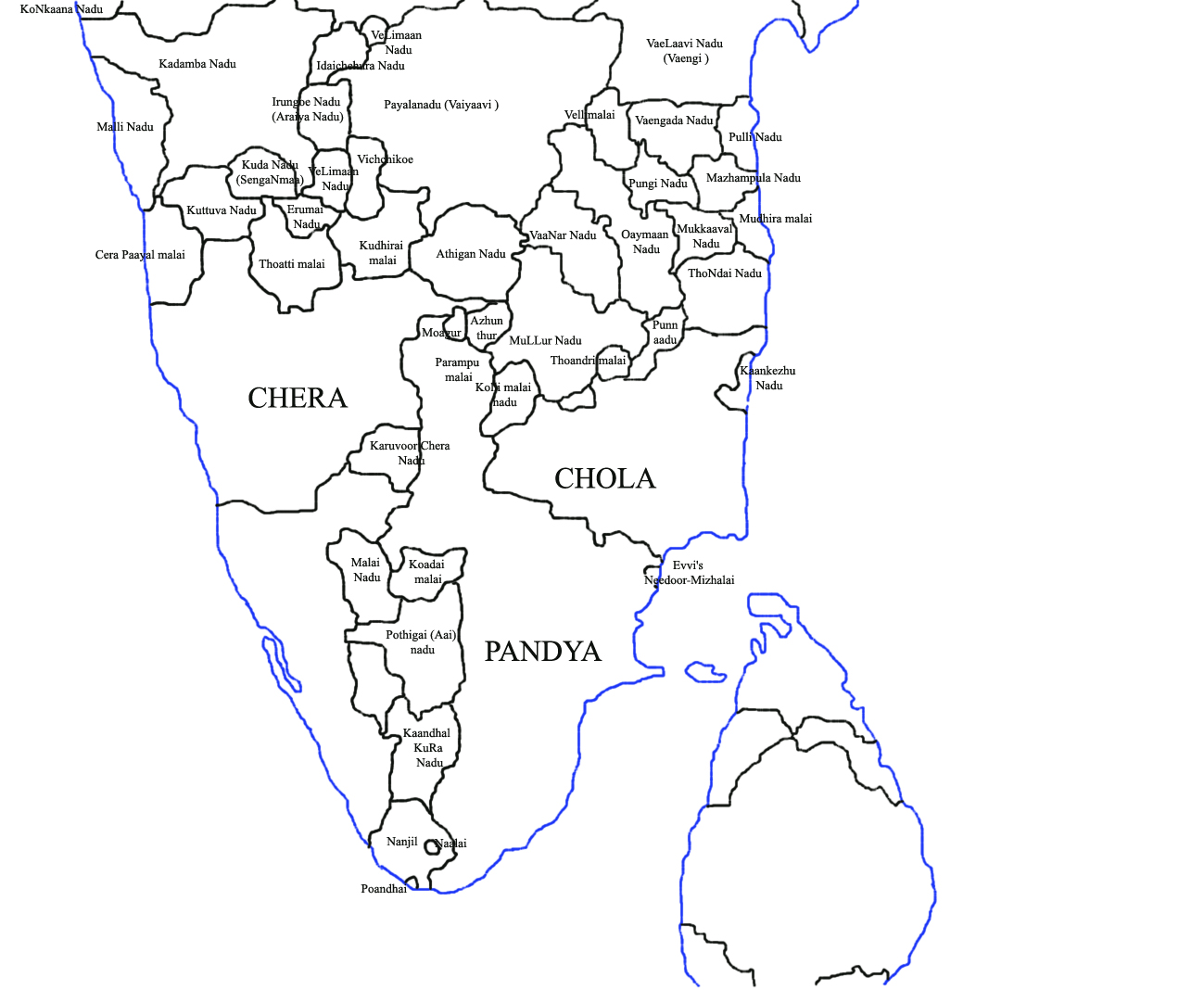Sangam period
Introduction -Sangam period
Sangam period (Tamil: சங்ககாலம், Sangakālam , Malayalam: സംഘകാലം ) is the period in the history of ancient Tamil Nadu (known as the Tamilakam) spanning from 3rd century BC to 3rd century AD.
In Old Tamil language, the term Tamilakam referred to the whole of the ancient Tamil-speaking area, corresponding roughly to the area known as southern India today, consisting of the territories of the present-day Indian states of Tamil Nadu, Kerala, parts of Andhra Pradesh, parts of Karnataka and northern Sri Lanka also known as Eelam
• The Cholas, Pandyas, Cheras and Satyaputras mentioned in Asok's inscription were probably in the Megalithic phase of material culture
• Sangam were societies of learned men. As per tradition there were three Sangam under the patronage of the Pandyan kings.
• The earliest inscriptions which mention the Tamil country are the Asoka inscriptions and the Hanthigumpha inscriptions
• First historical reference of Tamil comes from Megasthenese.
Three Early Kingdoms
The land south of the Krishna river was divided into three kingdom - Chola, Pandya and Chera.
Cheras
A.k.a - Keralputras
Capital - Vanji or Karur
Royal emblem - Bow
continuous fight with the Cholas and the Pandyas.
Nedunjeral Adan - first known Chera king
earned the title of Udiyanjiral.
Senguttuvan the Red or God Chera, was the greatest Chera king
invaded the north and crossed the Ganga
Built a temple of Kannagi
Cholas
Capital - Uraiyur later Puhar
royal emblem - Tiger.
Uruvapperhare-iulanjeltani - 1st Ruler
achievements
victory over rulers under the Chera and Pandyan kings at Venni, near Tanjore
conquered Sri Lanka
construction of Kaveri canal
was a master of seven musical nodes
Pandyas
Capital - Madurai
Royal emblem - corps/fish
Megasthenese stated - Pandyas were famous for Rule of women and Pearls
According to poet Bhangudi Marudan - 1st Pandyaan ruler was Nediyan
Sangam Literature
1> narrative - Melkannakku (Eighteen Major works)
2> didactic - Kilkanakku (Eighteen minor works)
Some Important Sangam Literature
Tirukkural -
also known as Veda of South or 5th Veda
Contains - Dharmashastra, Arthashastram & Kamasutra
Has -133 Chapters
Preaches - Simplicity and truth
Tolkappiyam -
One of the oldest Tamil literary works
Includes information on Grammar, Clasification of habitats, animals, plants & Humans,
Talks about human interactions & emotions
Political System

• Monarchial autocracy was at times mitigated by advice of ministers, poets & Scholars
• Brahmans had the foremost role among those whose assistance the king
• The Sangam rulers were famous for impartiality in justice
• The highest court in the state was king's assembly Manaram
• The king held a daily darbar, Nalavai, at which he settled disputes
• The group of five was a recognized body of a council
1. Ministers - Amaichchar
2. Purahis - Purahitar
3. Army - Senapatiyar
4. Envoys - Dutar
5. Spies - Orrar
• The entire kingdom (big or small) was called Mandalam
• The common most and possibly the largest single source of revenue was land tax. It was called Karai.
• Tax rate -1/6 of revenue
• Army consisted of 4 wings.
1. Chariots
2. Elephants
3. Cavalry
4. Infantry
• Most of the trade was carried on by barter. Paddy constituted the most commonly accepted medium of exchange
The market place was known as Avanam.
• The port of Karikal was famous for export of pearls.
• Puhar was a big sea port in Chola state and Port Bandar was in Chera state
• The ruling elite in the Sangam age was called Arasar
Virakal - denotes hero stones in honour of the heroes who died fighting for king
• Eripatti was the name of the tank
Religion
syntheis of local religious practices and Vedic Aryan religion
sage Agastya - took the Vedic religion to South
• The Brahmanas had established themselves as the priests of kings
The rulers patronized the Vedic religion and the performance of Vedic rites, rituals and Yogya was quite common
• Murugan/Subrahmanya/Velan was the most popular God of Sangam age.
Economics
Mainly categorized as
1> agriculturists
2> hunters
3> Fishesmen
Other etc
THE GRAND ANICUT, KALLANAI.Built in the 2nd Century by The Great Hindu King Karikala Cholan.
Kallanai (also known as the Grand Anicut) is an ancient dam built across the Kaveri River in Tiruchirapalli District in the state of Tamil Nadu in South India. Located at a distance of 15 km from Tiruchirapalli, World’s earliest water-regulator structure in stone.
Built by the Great hindu King Karikala Cholavar during the first century Karikala was a Chola king who ruled during the Sangam period. He is recognized as the greatest of the Early Cholas,
Grand Anicut (“Kallanai” in the local parlance), is one of the oldest water-diversion or water regulating structures in the world. 1,082 feet long with a maximum height of 18 feet and is 40-60 feet wide. It was remodeled and fitted with sluice gates in 1899-1902. For nearly two millennia it has irrigated a million acres of land. India had more land under irrigation in ancient times than it does today.

